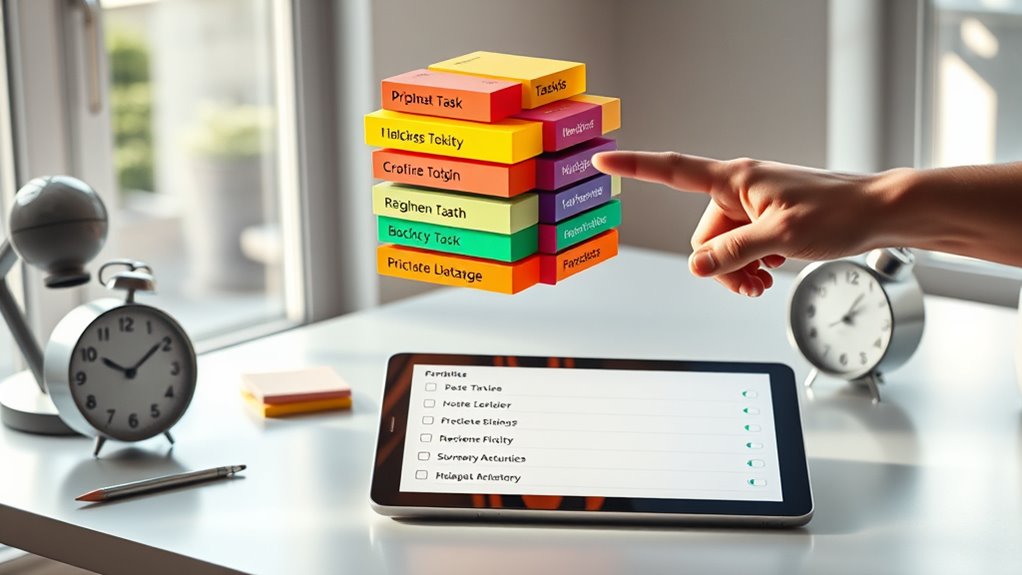To prioritize tasks with the 3D method, start by categorizing each task as Do, Defer, or Delete based on urgency and importance. Focus on completing the high-priority Do tasks first, schedule the Defer ones for later, and eliminate or postpone the Delete activities. This simple approach helps you stay organized, reduce stress, and make smarter decisions about where to put your effort. Keep exploring to discover practical tips for applying this method effectively.
Key Takeaways
- Categorize tasks into Do, Defer, and Delete to clearly identify their urgency and importance.
- Focus on completing Do tasks immediately, schedule Defer tasks for later, and eliminate Delete tasks to reduce clutter.
- Use the 3D method to streamline decision-making and prioritize high-impact activities effectively.
- Regularly review and adjust task categories to stay aligned with goals and deadlines.
- Incorporate healthy habits like proper nutrition to maintain energy and improve focus during prioritization.

Managing a busy schedule can feel overwhelming, but the 3D Method offers a straightforward way to prioritize tasks effectively. When you’re juggling multiple responsibilities, it’s easy to feel lost or unsure about what to tackle first. That’s where this method shines, providing a simple framework to improve your time management and boost your productivity techniques. By focusing on clarity, you can make smarter decisions about where to direct your energy, ensuring that your most important tasks get done without unnecessary stress.
The core idea behind the 3D Method is to categorize tasks into three groups: Do, Defer, and Delete. As you review your to-do list, ask yourself which tasks require immediate attention and which ones can wait. The “Do” category includes high-priority tasks that directly impact your goals or deadlines. These are items you should address as soon as possible, dedicating your energy to what truly matters. Next, the “Defer” group involves tasks that are important but not urgent. These can be scheduled for later, giving you room to focus on more pressing matters without neglecting less critical activities. In conclusion, the “Delete” category is for tasks that are neither urgent nor important. Eliminating or postponing these helps minimize distractions and frees up time for your top priorities.
In addition, incorporating healthy habits such as prioritizing proper nutrition can help maintain your energy levels and support your decision-making process throughout the day. Applying the 3D Method streamlines your decision-making process, making it easier to stay focused and organized. Instead of wasting mental energy pondering whether to do something now or later, you simply assign each task to one of the three categories. This approach enhances your time management skills by creating a clear visual of what needs immediate action and what can be pushed aside. It also encourages you to be honest about the value of each task, reducing the tendency to spend time on trivial activities that don’t contribute to your goals.
Frequently Asked Questions
How Does the 3D Method Differ From Other Prioritization Techniques?
The 3D method differs from other prioritization techniques by using a matrix comparison that evaluates tasks based on clear decision criteria. You compare tasks across dimensions like urgency, importance, and impact, making it easier to identify what to tackle first. Unlike simple lists, this approach provides a structured view, helping you make informed choices quickly and effectively, ensuring you focus on what truly matters.
Can the 3D Method Be Applied to Personal Life Tasks?
Absolutely, you can use the 3D method for personal goals and daily routines. It’s like giving your to-do list a superhero cape—distinguishing Do, Defer, and Delete helps you conquer chores and dreams alike. Instead of drowning in endless tasks, you focus on what truly matters, making your mornings smoother and your evenings more satisfying. Who knew prioritization could be this empowering, even outside the office?
What Tools or Apps Support the 3D Prioritization Approach?
You can use digital planners and task management apps like Todoist, Trello, or Notion to support the 3D prioritization approach. These tools help you categorize tasks into Do, Defer, and Delete, making it easier to visualize and manage your priorities. By integrating the 3D method into your digital planner, you stay organized, focus on high-impact tasks, and reduce overwhelm, ensuring your workload stays manageable.
How Long Does It Typically Take to See Results Using the 3D Method?
You’ll usually see results within a few weeks of consistently applying the 3D method. Timing expectations vary depending on your workload and commitment, but success indicators include increased productivity, clearer focus, and reduced stress. Stay patient and keep prioritizing tasks actively. Over time, you’ll notice better time management and more efficient task completion, confirming that your effort is paying off and the method’s positive impact is taking hold.
Are There Common Mistakes to Avoid When Implementing the 3D Method?
When implementing the 3D method, avoid common pitfalls like misclassifying tasks or rushing the process. Implementation errors often include neglecting to review and adjust priorities regularly or relying too heavily on initial assessments. To succeed, stay flexible, double-check your task categories, and make sure you’re consistently updating your priorities. This helps prevent mistakes that could delay results and keeps your workflow focused and effective.
Conclusion
Now that you know how to use the 3D method to prioritize tasks, you’re ready to take control of your day. It simplifies decision-making and keeps you focused on what truly matters. Will you let overwhelm dictate your schedule, or will you choose clarity and efficiency? By applying this technique, you can boost productivity and reduce stress. So, why not start today and see how much more you can accomplish?








